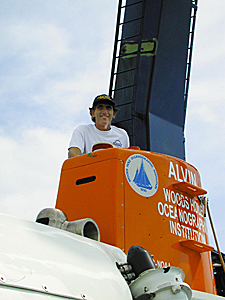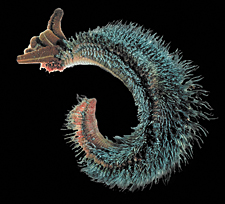- Rozovsky wins prestigious NSF Early Career Award
- UD students meet alumni, experience 'closing bell' at NYSE
- Newark Police seek assistance in identifying suspects in robbery
- Rivlin says bipartisan budget action, stronger budget rules key to reversing debt
- Stink bugs shouldn't pose problem until late summer
- Gao to honor Placido Domingo in Washington performance
- Adopt-A-Highway project keeps Lewes road clean
- WVUD's Radiothon fundraiser runs April 1-10
- W.D. Snodgrass Symposium to honor Pulitzer winner
- New guide helps cancer patients manage symptoms
- UD in the News, March 25, 2011
- For the Record, March 25, 2011
- Public opinion expert discusses world views of U.S. in Global Agenda series
- Congressional delegation, dean laud Center for Community Research and Service program
- Center for Political Communication sets symposium on politics, entertainment
- Students work to raise funds, awareness of domestic violence
- Equestrian team wins regional championship in Western riding
- Markell, Harker stress importance of agriculture to Delaware's economy
- Carol A. Ammon MBA Case Competition winners announced
- Prof presents blood-clotting studies at Gordon Research Conference
- Sexual Assault Awareness Month events, programs announced
- Stay connected with Sea Grant, CEOE e-newsletter
- A message to UD regarding the tragedy in Japan
- More News >>
- March 31-May 14: REP stages Neil Simon's 'The Good Doctor'
- April 2: Newark plans annual 'wine and dine'
- April 5: Expert perspective on U.S. health care
- April 5: Comedian Ace Guillen to visit Scrounge
- April 6, May 4: School of Nursing sponsors research lecture series
- April 6-May 4: Confucius Institute presents Chinese Film Series on Wednesdays
- April 6: IPCC's Pachauri to discuss sustainable development in DENIN Dialogue Series
- April 7: 'WVUDstock' radiothon concert announced
- April 8: English Language Institute presents 'Arts in Translation'
- April 9: Green and Healthy Living Expo planned at The Bob
- April 9: Center for Political Communication to host Onion editor
- April 10: Alumni Easter Egg-stravaganza planned
- April 11: CDS session to focus on visual assistive technologies
- April 12: T.J. Stiles to speak at UDLA annual dinner
- April 15, 16: Annual UD push lawnmower tune-up scheduled
- April 15, 16: Master Players series presents iMusic 4, China Magpie
- April 15, 16: Delaware Symphony, UD chorus to perform Mahler work
- April 18: Former NFL Coach Bill Cowher featured in UD Speaks
- April 21-24: Sesame Street Live brings Elmo and friends to The Bob
- April 30: Save the date for Ag Day 2011 at UD
- April 30: Symposium to consider 'Frontiers at the Chemistry-Biology Interface'
- April 30-May 1: Relay for Life set at Delaware Field House
- May 4: Delaware Membrane Protein Symposium announced
- May 5: Northwestern University's Leon Keer to deliver Kerr lecture
- May 7: Women's volleyball team to host second annual Spring Fling
- Through May 3: SPPA announces speakers for 10th annual lecture series
- Through May 4: Global Agenda sees U.S. through others' eyes; World Bank president to speak
- Through May 4: 'Research on Race, Ethnicity, Culture' topic of series
- Through May 9: Black American Studies announces lecture series
- Through May 11: 'Challenges in Jewish Culture' lecture series announced
- Through May 11: Area Studies research featured in speaker series
- Through June 5: 'Andy Warhol: Behind the Camera' on view in Old College Gallery
- Through July 15: 'Bodyscapes' on view at Mechanical Hall Gallery
- More What's Happening >>
- UD calendar >>
- Middle States evaluation team on campus April 5
- Phipps named HR Liaison of the Quarter
- Senior wins iPad for participating in assessment study
- April 19: Procurement Services schedules information sessions
- UD Bookstore announces spring break hours
- HealthyU Wellness Program encourages employees to 'Step into Spring'
- April 8-29: Faculty roundtable series considers student engagement
- GRE is changing; learn more at April 15 info session
- April 30: UD Evening with Blue Rocks set for employees
- Morris Library to be open 24/7 during final exams
- More Campus FYI >>
8:33 a.m., Nov. 19, 2008----You've heard of those relationships in nature where organisms from different species benefit from living or working closely together. Bees and flowering plants, for example, depend on each other: The insects get food and the plants are pollinated. One of the world's most unique examples of this phenomenon, known as symbiosis, is found at the bottom of the sea.
There, the Pompeii worm (Alvinella pompejana) lives at hydrothermal vents -- geysers on the seafloor that spew super hot, mineral-rich water. Enduring wide-ranging temperatures from about 72 to 176 degrees Fahrenheit, the worm is the world's most heat-tolerant animal. The worm also survives acidic water and conditions where sometimes there's no oxygen at all, so its home is one of the planet's most extreme environments.
Scientists trying to determine just how the worm tolerates the nearly boiling, toxic water have focused on the grey “fleece” of bacteria that live on the worm's back. The bacteria live and feed on mucus produced by the worm but they also serve as a source of food and vitamins for the worm.
To learn more about this symbiotic relationship, researchers sequenced the bacteria's genome, or studied their genes. The result, which was published Nov. 5 in the Proceedings of the National Academy of Sciences, is a catalog of everything the bacteria are capable of doing - from how they function to the nutrients they need to grow.
The project was led by Craig Cary, professor of marine biosciences in the University of Delaware's College of Marine and Earth Studies, and Alison Murray, a faculty member at the Desert Research Institute in Reno, Nev.
Cary is currently leading a research team that is exploring deep-sea hydrothermal vents in the Pacific Ocean as part of “Extreme 2008: A Deep-Sea Adventure.” To keep up with the expedition, go to the web site.
Collaborating on the Pompeii worm project were Desert Research Institute faculty member Joseph Grzymski, Barbara Campbell, UD assistant professor of marine biosciences, and Delaware Biotechnology Institute scientist Mihailo Kaplarevic.
Also working on the project were UD Distinguished Professor of Electrical and Computer Engineering Guang Gao and researchers from the University of Waikato in Hamilton, New Zealand, and SymBio Corp. of San Jose, Calif.
So what can the bacteria do? A lot, it turns out. The scientists believe they can endure the same huge range of temperatures that the worms experience. They also can thrive in diverse chemical environments (hydrogen sulfide and heavy metals are common around the vents) and can process both oxygen and organic matter to make energy.
“In the hydrothermal vents there's mixing between the hydrothermal fluids and the seawater and that mixing creates a very dynamic environment,” Campbell said.
But this wide range of traits doesn't belong to just one type of bacteria. The researchers found that the organisms living on the worm's back represent many closely related but diverse members from one strain of bacteria called Epsilonproteobacteria. The team believes that each type of bacteria is optimally adapted to specific temperature ranges and other conditions, allowing the community living on the worm's back to thrive in the ever-changing, hostile ecosystem in which they live.
“Most symbioses in nature include one bacterium that is actually controlled and nurtured by the host, but in this situation we have many different types of bacteria,” Cary said. “That's very unusual.”
Members of the research team discovered the Epsilonproteobacteria in the early '90s and have been working to understand them better ever since. That growing bank of knowledge could benefit an industry looking to develop a variety of products and applications, from new pharmaceuticals to enzymes capable of operating in hot, corrosive, high-pressure environments.
“This is probably one of the first studies to look at a symbiosis of this extreme environment and dissect it down to its bottom line, basically the recipe of success for these organisms,” Cary said. But the researchers have only just begun to describe what the bacteria can do.
Article by Elizabeth Boyle




